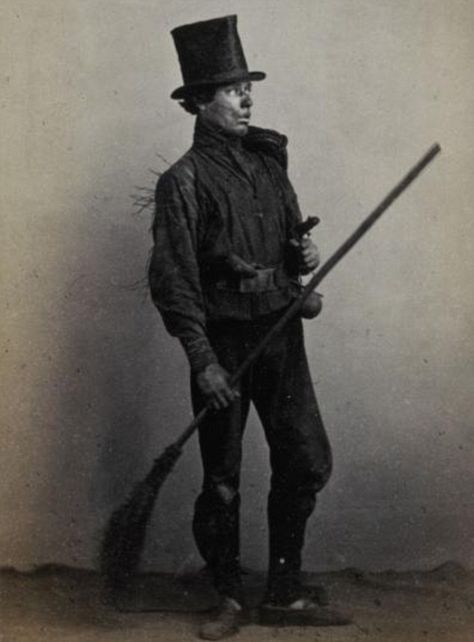Runaway Servants
Servants played an important role in the economy of colonial and post-Revolutionary War America.

Fire was people’s greatest fear, especially in towns where houses and buildings were often attached to each other in rows. If chimneys were not maintained and swept on a regular basis, they could take fire and blaze out the top spewing flames and sparks and endangering surrounding houses, stables, and structures.
“Master Sweeps took in homeless young boys or bought young children from orphanages or from destitute parents; and the children were supposedly chimney sweep apprentices. Instead, they were nothing less than indentured servants, harshly treated and forced to work from dawn until dusk every day of the year but one. The small boys used as chimney sweeps were typically between 5 and 10 years of age, and some were as young as 4 years old. They clambered up chimneys with brushing and scraping tools that knocked the creosote and soot from the chimney lining. The boys also had metal scrapers and small brushes to remove hard tar deposits. After reaching the top, the boys slid back down and collected the soot pile, which the master sold to farmers as fertilizer.
The chimney sweeps were not given any type of respiratory equipment or protective clothing. They suffered many health problems because of their constant exposure to soot and because of the unnatural positions they were in so much of the time. Work-related health problems included: deformed ankles, twisted kneecaps, twisted spines, inflammatory eye syndrome, and respiratory illnesses.” 1
The physical conditions of chimney sweeps are evident in the descriptions of them given in the newspaper by their masters who offered a reward for their return. Robert Kennedy, the servant of Robert Cooper of Shippensburg, ran away in August 1776. He was described as “about fifteen years old, of low stature for that age, but of a thick clumsy make, of a sour down look, has remarkably big feet and is clumsy in his gait, has scars from old sores upon his legs, was bred to the business of chimney sweep in Ireland.” He described the clothes Kennedy had on when he ran away and noted that he had no shoes. He offered a three-dollar reward to anyone who secured him in jail or brings him to apothecary Jonathan Kearsley in Carlisle or to the subscriber in Shippensburg.2
In 1771, George Beatho [sic] of Philadelphia, advertised for the return of two runaway chimney sweeps. One of them was James Winterbottom, an English servant boy who was a sweeper by trade. He “had on and took away with him…a chimney frock and trowsers, blanket, brush, and scraper. He is about 17 years of age, 4 feet 7 inches high, wears his own hair of a brown colour, is weak and hollow-eyed, waddles in his walk, and stammers much when talking, and has a down sneaking look.” He also ran away with a “Negro boy slave,” named Prime or Primus, aged about 26 years, 5 feet 3 inches high” who was also a chimney sweeper by trade. “He had on and took away with him a chimney frock and trowsers, blanket, brush, and scraper.3 James Winterbottom was caught and returned to his master, but that did not stop him. He ran away at least two more times. When he ran away in 1773, he was 19 years old. His master said, “He may alter his clothes, but he cannot alter his legs, they are thick in the small and both marked with fire.” An additional detail in his description was that Winterbottom had a cap on, “his number is 15, made of tin.”4 Chimney sweeps were required to put their number (which could not be under two inches in height) on a tin or copper plate mounted on the front of their cap in full view of everyone.5 The last mention of James Winterbottom in the Philadelphia newspapers was in June 1774. Described as 5 feet in height; “his heels are black with the chimney walls, and the small of his legs near as big as his calf, on one is a small fire mark from his birth.”6
One of the reasons that advertisements for Carlisle and Cumberland County runaways were placed in Philadelphia newspapers was because Carlisle’s first newspaper was not published until 1785. No advertisements for runaway chimney sweeps were found in the Carlisle newspapers between 1785 and 1810. The first and only mention of a chimney sweep in a Carlisle newspaper was in the spring of 1786 when James O’Flaherty, “chimney doctor,” arrived in Carlisle. He advertised that he “undertakes to cure chimnies in the free emission of smoke, sets the different kinds of fire-works, such as perpetual boilers, metal and common ovens, grates, stew holes, stoves, French and English kilns, cisterns, stills, pans or pots and hatters’ planks, lay hearths; he is to be heard of at Thomas Alexander’s.” 7
Servants played an important role in the economy of colonial and post-Revolutionary War America.
1 Child Chimney Sweeps: Dark Chapter in Sweep History - (chimneysolutions.com)
2 The Philadelphia Journal, or Weekly Advertiser, Philadelphia, October 2, 1776.
3 The Pennsylvania Gazette, Philadelphia, December 26, 1771.
4 The Philadelphia Journal, or Weekly Advertiser, Philadelphia, April 28, 1773.
5 An Act regulating chimney sweepers within the city of Philadelphia, the district of Southwark and the township of the Northern-Liberties in the city of Philadelphia,” passed by the General Assembly of the Commonwealth of Pennsylvania on November 29, 1779.
6 The Philadelphia Journal, or Weekly Advertiser, Philadelphia, June 22, 1774.
7 The Carlisle Gazette, and the Western Repository of Knowledge, April 5, 1786.